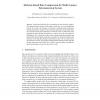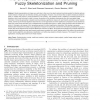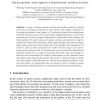667 search results - page 26 / 134 » Exceptions for Algorithmic Skeletons |
ECCV
2008
Springer
14 years 10 months ago
2008
Springer
Abstract. Humans demonstrate a remarkable ability to parse complicated motion sequences into their constituent structures and motions. We investigate this problem, attempting to le...
ISVC
2007
Springer
14 years 3 months ago
2007
Springer
Abstract. Image-based full body 3D reconstruction for tele-immersive applications generates large amount of data points, which have to be sent through the network in real-time. In ...
COMPGEOM
2003
ACM
14 years 2 months ago
2003
ACM
We propose a novel type of decomposition for polygonal shapes. It is thought that, for the task of object recognition, the human visual system uses a part-based representation. De...
PAMI
2010
13 years 7 months ago
2010
—Medial representations of shapes are useful due to their use of an object-centered coordinate system that directly captures intuitive notions of shape such as thickness, bending...
CAIP
2005
Springer
14 years 2 months ago
2005
Springer
In order to achieve precise, accurate and reliable tracking of human movement, a 3D human model that is very similar to the subject is essential. In this paper, we present a new sy...



